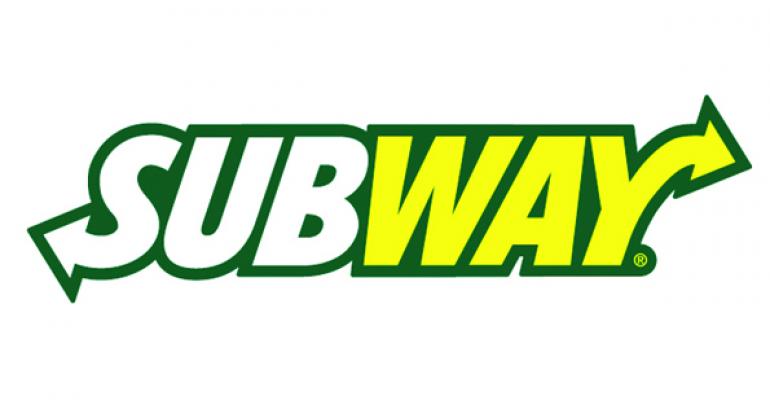Subway’s long-running marketing campaigns with spokesman Jared Fogle and athlete “famous fans,” which help consumers identify with the sandwich chain, pushed it to the top of a new study of the best-perceived brands.
According to a report from Technomic Inc. and its Consumer Brand Metrics subsidiary, Subway led all restaurants in a composite score of consumers’ ratings for its advertising on three attributes: “has memorable advertising,” “has advertising I can relate to” and “has advertising that makes me hungry.”
RELATED
• Most influential restaurant ads in 3Q push value
• What's next for McDonald's marketing
• More restaurant advertising news
Scores for each brand are expressed in percentages of consumers who agree the brand’s advertising is memorable, relatable or appetizing. Subway led all brands with a composite score of 73.3 percent.
In the second quarter of 2013, its attribute scores for memorable advertising and relatable advertising were 78.5 percent and 75.1 percent, respectively. Its score for “advertising that makes me hungry” was 69.4 percent, making Subway a rare exception to an industrywide trend of brands scoring better for appetizing advertising than for marketing that viewers find relatable or memorable, Technomic found.
“On the whole, leading restaurant chains appear to be struggling to connect with consumers amid fierce competition for limited attention,” the study said. “Low ratings for memorable and relatable advertising across the industry signal an opportunity for restaurant marketers to build brand equity with new creative work.”
Technomic’s study took a “holistic” view of restaurant companies’ advertising, surveying consumers on any interaction with the brands from television, print, out-of-home, radio, in-store, or digital and social media. The Chicago-based market research firm surveyed 78,743 respondents on their opinions of more than 100 brands between the first quarter of 2012 and the second quarter of 2013.
“Further,” the study said, “these attributes are rated by consumers who are familiar with the brand and visit it with any level of frequency, ensuring a portrait of the brand’s perception among all of its consumers, not just core users.”
Subway wins with Jared and jocks
Technomic conceded that Subway’s size of more than 24,000 restaurants in the United States and its marketing budget of more than $500 million helped the study’s rankings, yet the firm said Subway’s creative strategy of aligning with famous athletes and everyman spokesperson Jared Fogle made the chain’s ads memorable and relatable.
Subway’s long-running campaigns hit occasional snags, such as a 2009 incident where spokesman Michael Phelps was photographed smoking marijuana, and a period in 2005, when sales fell 10 percent because Fogle’s contract expired and his commercials disappeared. Also in 2010, Fogle strayed from the “Subway diet” he made famous and gained 40 pounds. But keeping these spokesmen ultimately benefited Subway, which saw its perceptions rebound, Technomic found.
“Just as Subway stuck with Michael Phelps, the brand stayed loyal to Jared, encouraging him to train for and finish the New York City Marathon that year,” the study said. “The length and authenticity of Jared’s endorsement as a real person who, despite his struggles, has maintained a healthy lifestyle by eating Subway most likely resonates with consumers on ‘has memorable advertising’ and ‘advertising I can relate to.’”
Other brands could learn from Subway’s success in using a spokesperson to show how they relate to real people, Technomic’s study found, but only if the fit is authentic.
“It is important for the endorser, celebrity or otherwise, to be a genuine fan of the brand and trustworthy in delivering the message,” the study said. “While not every brand can or should have a ‘Jared,’ brands’ communication with consumers should reflect an understanding of how that brand fits into the consumer’s life.”
The best of the rest
Subway’s success in producing relatable and memorable campaigns has put it ahead of the rest of the restaurant industry, which on average has been more successful at producing “advertising that makes me hungry.”
In the second quarter of 2013, the average score for all restaurants on that appetizing-advertising metric was 59.1 percent, well ahead of the industry averages for “has memorable advertising” and “has advertising I can relate to,” which were 53.2 percent and 50.2 percent, respectively.
Four other quick-service chains and five casual-dining chains joined Subway in the top 10 overall composite scores in Technomic’s study. Olive Garden finished second, with a composite score of 72.9 percent, followed by Sonic Drive-in, Red Lobster and Popeyes Louisiana Kitchen. Chili’s, Applebee’s, Chick-fil-A, Red Robin and Little Caesars Pizza rounded out the top 10.
“Many leading restaurant brand advertisers are absent from this [top 10] list,” the study noted, including the major pizza chains — Pizza Hut, Papa John’s and Domino’s finished at Nos. 11, 12 and 18, respectively — and McDonald’s, which finished with the 16th highest composite score.
“Taco Bell (23rd place), Wendy’s (26th place) and Burger King (39th place) appear even further down the list,” the report continued, “signaling that these brands’ advertising is not connecting as successfully with consumers. However, Taco Bell’s composite score increased by 10 percentage points from the first quarter of 2012 to the second quarter of 2013, likely fueled by the brand’s ‘Live Más’ campaign and the launches of each new flavor of Doritos Locos Tacos.”
Technomic added that a chain’s size or marketing budget need not determine its marketing perceptions, citing a brand like Chick-fil-A, which has used its “Eat Mor Chikn” cows for more than a decade to build a memorable campaign.
“Advertising spend does not necessarily translate into advertising effectiveness,” the study said. “Brands with smaller budgets can outpace larger rivals on the advertising attributes we measure by extending a simple, sticky message across a variety of advertising touch points.”
Contact Mark Brandau at [email protected].
Follow him on Twitter: @Mark_from_NRN

